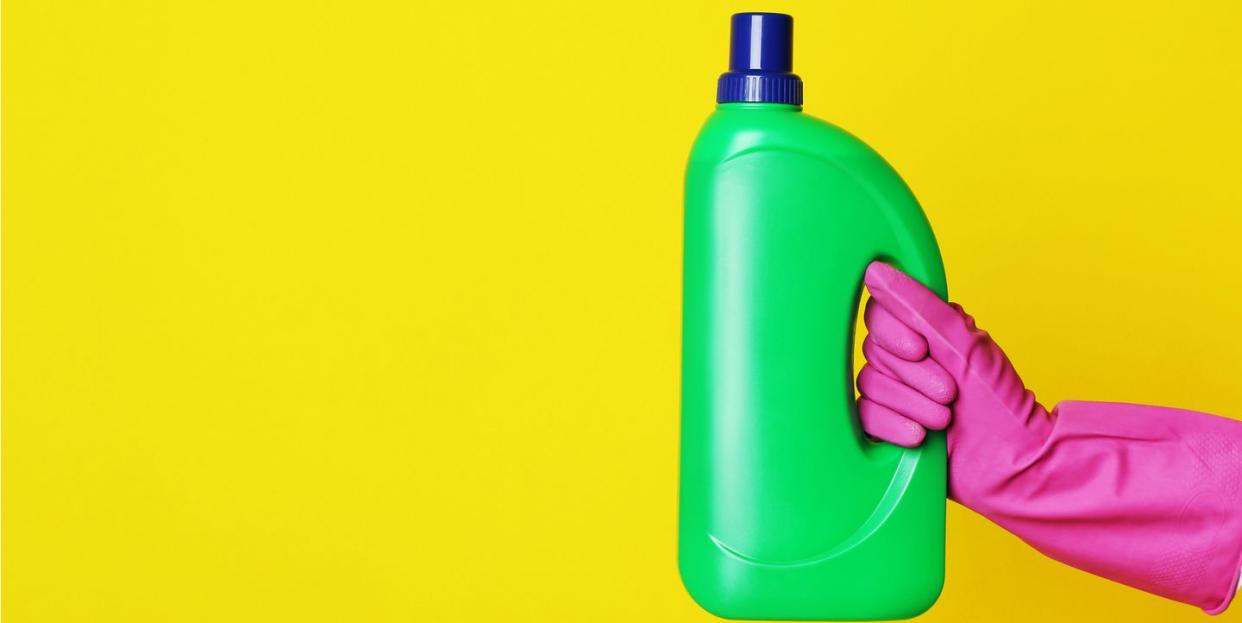Here's How to Be Sure You're Using Bleach Properly

If you've found yourself with extra time on your hands, plus a serious propensity to clean all the things, you might be looking at that bottle of bleach wondering how it can help you make your home sparkle and—more importantly—keep it germ-free. From disinfecting clothes to bathroom and kitchen surfaces, bleach is indeed good for cleaning, but there's a lot you should know about the strong agent before you go ahead and douse your furniture with it. Heres how to use bleach safely.
Before you do anything, make sure your product disinfects.
There's an important distinction between disinfecting and sanitizing, says Mary Gagliardi, in-house cleaning expert at Clorox. "Disinfecting removes both bacteria and viruses, whereas sanitizing only removes bacteria."
If your goal is to disinfect, make sure the bleach you're using has an EPA registration number on the back panel, says Gagliardi. "Thickened bleach products and fragranced bleach products are not EPA registered to disinfect."
And always dilute bleach.
To safely clean with bleach and properly disinfect—not just sanitize—be sure to follow the instructions on your particular product, as usage instructions vary from product to product, says Gagliardi.
But never mix it with anything but water.
Bleach should only be mixed with water, says Gagliardi. Do not mix bleach with other cleaning products or household staples like vinegar, which can release toxic vapors.
Make sure to clean for the required amount of time.
You'll also want to check the label for something called "contact time." This indicates how long the bleach solution should be in contact with the surface to disinfect, says Gagliardi. The length of time might surprise you, too. Clorox, for example, needs to make contact with non-porous surfaces, like countertops or doorknobs, for five minutes.
And make sure the dilution is fresh.
After cleaning, don't store any leftover product. "The bleach and water solution must be made fresh each day you use it," says Gagliardi.
Here's how to use bleach to clean bathrooms and other surfaces in your home.
Because bleach is a powerful disinfectant when used properly, it's often used to clean bathrooms or to wipe down commonly-touched and shared surfaces that can lead to germ transmission—counter tops, faucets, cabinet handles, doorknobs, the trashcan lid, toilet seats, and the refrigerator doors, says Gagliardi. (Always consult your product to determine whether it's safe to use on these surfaces and items in your home.)
Specific usage instructions will also vary from product to product, but steps generally look something like this:
Pre-wash the surface—water and a gentle soap (like Castile soap) will suffice.
Wipe the surface with the proper dilution, as recommended on the bottle.
Allow solution to stay in contact with the surface for the amount of time indicated on the bottle.
Rinse with warm water and let air dry.
How to use bleach to sanitize clothes and remove stains.
Bleach is also commonly used in the laundry room, since bleach can lend extra cleaning power when sanitizing bedding and towels, plus remove stains and brighten whites.
To use bleach for this purpose:
Machine wash your items in the hottest water recommended using laundry detergent and bleach (check your product for specific amounts).
Make sure the load comes into contact with your clothes for the amount of time recommended on the bottle.
As a general rule of thumb, bedding should be washed at least weekly, towels should be washed semi-weekly, and if you have a family member who is sick, they should not share any laundry with others in the home, says Gagliardi.
And don't forget: Certain types of bleach can ruin dark clothes. If you're sanitizing or treating stains on darker colored clothes, be sure to use a non-chlorine bleach.
For more stories like this, sign up for our newsletter.

